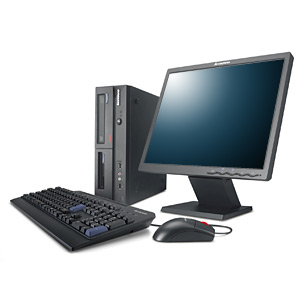Modern computers come in many shapes and sizes. From desktops and towers, to laptops, netbooks, tablets and some smart phones are all computers. While they look different, they share the same basic features and functions.
This quick tutorial should help familiarize you with the parts of a computer system.
All computers are made up of four basic building blocks. Here is a quick overview:
- Input: how the computer gets information from you, usually through a keyboard or mouse.
- Processing: once you tell the computer what to do, it has to process the information and communicate the result back to us or store it for later retrieval.
- Storage: a computer can save information in two basic ways; temporary storage (in memory chips), and more permanent storage (saved to the hard drive or other storage media).
- Output: once a computer has processed information it often will send the results back to you through a display monitor or printer.
The Computer System
The typical desktop computer system consists of the computer (either desktop or tower unit), a monitor, a keyboard, and a mouse. A complete computer system also includes a set of speakers and a printer.
Inside the Computer Case
The box (or case) of the desktop or tower computer contains several electronic components:
Motherboard, the main circuit board where the processor, memory chips, and expansion cards are attached.
Power supply, converts power from your AC wall outlet to low-power DC needed by the computer components.
 |
| A peek inside the Hard Drive |
Removable Media Drives, allow the reading and writing of data to CD, DVD, and Blu-Ray discs. Removable media may also be in the form of USB thumb-drives, ZIP-disks, tape backups, or memory chips usually used in digital cameras.
The Changing Form of the Personal Computer
The desktop computer is the traditional form of a personal computer. There are a variety of form factors that computers come in, including:
 |
| Laptop and Netbook size comparison |
Netbook, A small laptop computer that is smaller than a notebook, designed primarily for accessing Internet-based applications.
 |
| all-in-one computer |
While desktop and tower computers offer greater expandability, all-in-one's offer style.
Tablet Computer, a type of notebook computer that has an LCD screen on which the user can write using a special-purpose pen, or stylus. Some tablets use touch screens and allow the user to use tap the screen with their fingers.
Common Input Devices
Keyboard
A keyboard is used for typing text into the computer. A keyboard can be a physical keyboard with real keys, or a virtual keyboard on a touch screen. It has keys for letters and numbers, as well as special keys:
Navigation Keys or Touch Pad, allows you to move your position within a document, application, or web page.
 |
| Apple's iPad tablet has a virtual keyboard. |
Numeric Keypad, provides quick 10-key number entry.
Programmable Keys, some keyboards have special keys you can program to launch your favorite applications (like email, web browsing). Certain games and programs can have actions assigned to the programmable keys as well.
Mouse
A mouse is a small device used to point and select items on your computer screen. A mouse has one or more buttons, and may include a wheel to help scroll the screen. When you move the mouse with your hand, a pointer on your screen moves in the same direction. When you want to select an item, you point to the item and then click (press and release) the left button.Mac computers usually come with a mouse that has a single button. Windows computers typically employ a two-button mouse. Clicking the secondary button (called a "right click") brings up an options menu. Mac users hold down their Control key on the keyboard and press the mouse button to perform a right click.
Touchpad
A touchpad is a small touch-sensitive device that senses the position of the user's finger and moves the pointer on the screen accordingly. Touchpads are commonly found on laptop computers and some keyboards.Buttons below the touchpad work in the same manner as buttons on a mouse. In the picture at right, the touchpad includes a scroll bar which serves the same purpose as a wheel on a mouse.
Laptop computer's usually have a key or button that allows the user to turn off the touchpad. This is handy if you wish to type without accidentally moving the cursor, or if you intend to use a traditional mouse instead.






